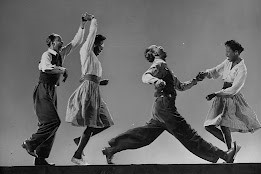Lindy Hop facts for kids


The Lindy Hop is a super fun American dance! It was born in the African-American communities of Harlem, New York City, in 1928. This dance became really popular during the swing era in the late 1930s and early 1940s.
Lindy Hop is a mix of many older dances. It mainly combines moves from jazz, tap, breakaway, and the Charleston. It's often called a jazz dance and belongs to the swing dance family.
When it was created, Lindy Hop brought together different dance styles. It used the free, creative movements of African-American dances. It also used the more structured, eight-count steps of European partner dances. You can see this mix clearly in the Lindy's main step, called the swingout. In this step, dancers can be connected hand-to-hand (open position) or in a closer hug-like hold (closed position).
The Lindy Hop's Comeback
After being very popular, interest in Lindy Hop faded for a while. But in the 1980s, dancers from America, Sweden, and Britain helped bring it back! Today, Lindy Hop is danced all over the world. You can find dancers and groups in North America, South America, Europe, Asia, and Oceania.
Lindy Hop Today
Today, people dance Lindy Hop in many ways. It's a popular social dance where people dance just for fun. It's also a competitive dance, where dancers show off their skills. Sometimes, it's a performance dance for shows. You can learn Lindy Hop in classes, workshops, and special dance camps. Dancers can dance alone or with a partner. Being creative and making up moves on the spot (called improvisation) is a big part of social dancing and many performances.
Lindy Hop as a Street Dance
Lindy Hop is sometimes called a "street dance." This is because it's often danced freely and socially, even outdoors. In 1932, a twelve-year-old girl named Norma Miller danced the Lindy Hop outside the famous Savoy Ballroom with her friends. They danced for tips!
A few years later, in 1935, about 15,000 people danced the Lindy Hop on Bradhurst Avenue in Harlem. This was part of a dance series held by the Parks Department. People from the nearby Sugar Hill area watched from the bluffs as Harlem "threw itself into the Lindy hop with abandon."
See also
 In Spanish: Lindy hop para niños
In Spanish: Lindy hop para niños


